
1. Lesson 4
1.1. Assessment
1.1.1. Formative
1.1.2. Students will complete matching games of images and word descriptions in relation to lifecycles, pollination and bees
1.1.2.1. Images of students work will be taken.
1.2. Goal
1.2.1. Students will correctly match the parts and stages of life cycles to either an image or wording.
1.3. Content Descriptor
1.3.1. Living things depend on each other and the environment to survive (ACSSU073)
1.3.2. Living things have life cycles (ACSSU072)
1.4. Materials
1.4.1. Matching Games
1.4.2. Who am I - question cards
1.4.3. Camera
1.4.4. Kahoot Quiz (for students behaving)
1.5. Tasks
1.5.1. Students will be give a options of matching activities, who am i cards to use throughout the lesson. When students complete the lesson they will have images of their work taken for record keeping
1.5.2. Students who are behaving appropriately will have the opportunity to complete fun kahoot quizes.
2. Lesson 5
2.1. Assessment
2.1.1. Summative
2.1.2. Students will complete 3 rotations that are all 15min long.
2.1.2.1. Each rotation will demonstrate their current knowledge of the concepts learnt through the 5 week unit.
2.1.3. Students will be assessed on:
2.1.3.1. Plant life cycles
2.1.3.2. Parts of a Flower Plant
2.1.3.3. Pollination
2.2. Goal
2.2.1. Students will correctly identify and label the parts of a flower plant.
2.2.2. Students will video themselves correctly demonstrating how a bee collects and spreads pollen.
2.2.3. Students will correctly place images of a plant life cycle in a flowchart.
2.3. Content Descriptor
2.3.1. Living things have life cycles (ACSSU072)
2.3.2. Living things depend on each other and the environment to survive (ACSSU073)
2.4. Materials
2.4.1. 9 Laptops
2.4.2. 9 Fake Flowers
2.4.3. Dry Paint
2.4.4. Pipe Cleaners
2.4.5. 9 Ipads
2.4.6. Plant life cycle diagram
2.5. Task
2.5.1. Students will begin with an introduction to the tasks.
2.5.2. Students will be grouped into 3 different groups and work at each station for around 15min.
2.5.3. Group 1 - Students will complete a plant life cycle cut and paste activity. Students will be given the opportunity to demonstrate any other knowledge they have on the plant stages.
2.5.4. Group 2 - Students will complete a computer game that allows them to add the labels of a plant.
2.5.5. Group 3 - Students will be given the equipment needed to demonstrate a bee pollinating a plant. Students will then film themselves completing this.
3. Lesson 1
3.1. Assessment
3.1.1. Diagnostic
3.1.2. Students will label the parts of a plant and flower
3.1.3. Students will create a flow chart of the life cycle of a plant
3.2. Goal
3.2.1. Students will demonstrate their prior knowledge on lifecycles of living this.
3.2.2. Students will correctly label a diagram of a plant and a flower.
3.3. Content Descriptor
3.3.1. Living things have life cycles (ACSSU072)
3.4. Materials
3.4.1. Student resource book
3.4.1.1. Diagram of a plant
3.4.1.2. Cross-section diagram of a flower
3.4.1.3. Flow Chart template
3.4.1.4. Plant Trouble template
3.4.2. SmartBoard
3.4.3. Powerpoint of lesson structure
3.5. Tasks
3.5.1. 1. Students complete questions based on a plant problem passage individual and then share with the class.
3.5.2. 2. Students will then complete the life cycle of a plant flow chart where they glue the stages in regards to where they fit along the life cycle (individually).
3.5.3. 3. Complete two plant/flower diagrams filling out the labels (individually).
3.5.4. 4. Fill out an exit slip at the end of the lesson to reflect on the current knowledge.
4. Lesson 2
4.1. Assessment
4.1.1. Formative
4.1.2. Anecdotal notes on sticky notes about student participation and concepts that are on being understood.
4.2. Goal
4.2.1. Students will complete orally describe the parts of a bee life cycle
4.2.2. Students will complete work that was not completed the week before.
4.3. Content Descriptor
4.3.1. Living things have life cycles (ACSSU072)
4.4. Materials
4.4.1. Student Resource book
4.4.1.1. Bee Life Cycle dial
4.4.2. Smart Board
4.4.3. Powerpoint on Bee Life Cycle
4.4.4. Look at the bee - What do you see?
4.5. Tasks
4.5.1. 1. Students will be reintroduced to the plant diagrams that were explored last week. On a poster board show students the correct parts of a flower and what they are for.
4.5.2. 2. Students will then participate in a whole class discussion on the parts of a bee life cycle. and make a dial to remember.
4.5.3. 3. Students will then look at a variety of bee images, add sticky notes to a big images and discuss what they see.
5. Lesson 3
5.1. Assessment
5.1.1. Formative
5.1.2. Students will be introduced to the concept of pollination.
5.1.3. Kahoot quiz to see memory retention.
5.2. Goal
5.2.1. Students will be able to articulate the process of pollination of a bee and flower.
5.2.2. Students will recognise the importance of the relationship between bee and flower.
5.3. Content Descriptor
5.3.1. Living things depend on each other and the environment to survive (ACSSU073)
5.4. Materials
5.4.1. StoryBoard
5.4.2. Smartboard
5.4.3. Youtube Video
5.5. Tasks
5.5.1. Students will be have a whole class discussion about the job of a bee.
5.5.2. Students will then make connections between Bees and plants
5.5.3. Watch video on pollunation
5.5.4. Why is pollination important?
5.5.5. Make a storyboard about pollunation
5.5.6. Complete a Kahoot quiz in groups about the stages of pollination
